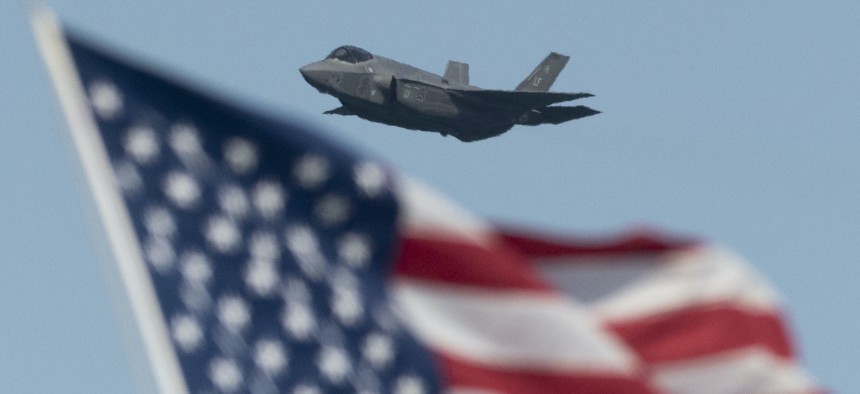
U.S. Air Force F-35 Lightning flies over the San Francisco Bay in San Francisco, California, October 13, 2019. NurPhoto via Getty Images / Yichuan Cao
The F-35’s Painful Lessons Must Inform Future Programs
Congress and the Pentagon must question dubious technical requirements, rosy buy-in costs, and optimistic schedule promises.
The F-35 program will turn 20 years old this fall. That’s longer than the entire service life of many legendary aircraft programs. The B-36, for example, was retired 13 years after its first flight in 1946. The F-86 went from first flight to retirement in 18 years.
But two decades in and at a cost of $177.6 billion and counting, the F-35 remains functionally a prototype unready for full-rate production. The program still struggles with nearly 900 design flaws, cannot be relied upon to perform well, and is unaffordable in the numbers the services need. The military can and should learn some very important lessons from this painful experience before it commissions another major weapon.
“Fly before you buy.” The Pentagon awarded the development contract for the F-35 in 2001, based on technology demonstrators, not production-ready aircraft. The subsequent two decades have shown that the promises made about the aircraft’s capabilities were unrealistic. The services are now saddled with more than 400 F-35s, all of which will require years of costly upgrades before they can come close to meeting the original program goals.
Putting immature and unproven technology into production wastes taxpayer dollars, but more importantly, it undermines readiness and endangers lives. As former Pentagon acquisition chief and current Air Force secretary nominee Frank Kendall once said, rushing the F-35 into production was “acquisition malpractice.” Indeed, the National Commission on Military Aviation Safety found that the F-35’s unexpectedly high maintenance costs have drained resources from the services’ other operational aircraft programs. New efforts to speed up the acquisition process could accelerate this drain.
Decisions must be made on good data and realistic plans. Time and again, marquee weapons programs see massive cost increases when the contractors fail to deliver promised capabilities. It’s common defense industry practice for contractors to claim they will be able to deliver the new weapon with revolutionary capabilities at an affordable price. Then, as soon as Congress authorizes the program, the contractor spreads money throughout the country to solidify political support, making the program nearly impossible to kill when costs rise.
Decisionmakers in Congress and the Pentagon need to question dubious technical requirements, rosy buy-in costs, and optimistic schedule promises while remembering that technical revolutions cannot be bought at rock-bottom prices. Not doing so gave us expensive acquisition failures like the Future Combat System, the Expeditionary Fighting Vehicle, and the Zumwalt-class destroyers, in addition to the F-35.
The Pentagon should only buy the simplest tools possible for their intended tasks. Because the F-35 needs to perform multiple roles for three separate services and meet the requirements of six partner nations, it is an inherently complex aircraft. Plus, the contractor created as many subcontracts as possible to shore up political support, cramming in additional features used to dazzle members of Congress and sympathetic members of the media. As the services review designs for future weapons, rigorous discipline must be applied during engineering and manufacturing development to strip out as many unnecessary features as possible and ensure that only what is absolutely crucial to accomplish the mission remains. Doing so, especially with the next fighter program, will ensure the new system is easier to maintain, has high availability, reduces costs, and potentially saves lives.
Development contracts must secure the data rights. The Pentagon voluntarily surrendered a great deal of control over the F-35 program when transfer of the intellectual property for the program’s design and operations were not included in the original development contract. As a result, F-35 maintainers were unable to perform many essential repairs because they did not have access to the relevant technical data or specialized tools, the Government Accountability Office recently found. Instead, the services are forced to rely on costly contractors to do the work traditionally performed by uniformed personnel. This scheme also means the government can’t competitively bid F-35 sustainment contracts because no one but Lockheed Martin has the necessary data to perform the work. The current affordability concerns about the F-35 program stem directly from the intellectual property rights issue and will continue to be an ongoing problem as the program continues through the modernization process over the next 10 years.
It is far too late to apply these lessons to the F-35, but the painful lessons learned now need to be internalized and properly applied as the Pentagon starts the process again on the next shiny object.
Dan Grazier is the Jack Shanahan Military Fellow at the Project On Government Oversight. He is a former Marine Corps captain who served tours of duty in Iraq and Afghanistan during the war on terror. His various assignments in uniform included tours with 2nd Tank Battalion in Camp Lejeune, North Carolina, and 1st Tank Battalion in Twentynine Palms, California.
NEXT STORY: Is DarkSide Really Sorry? Is It Even DarkSide?



